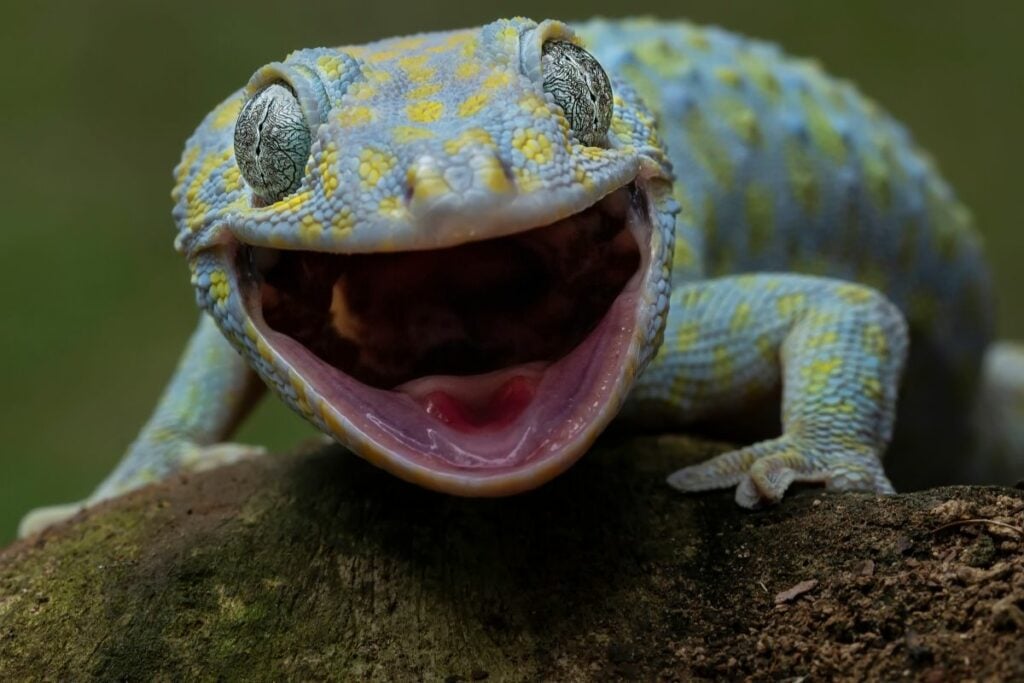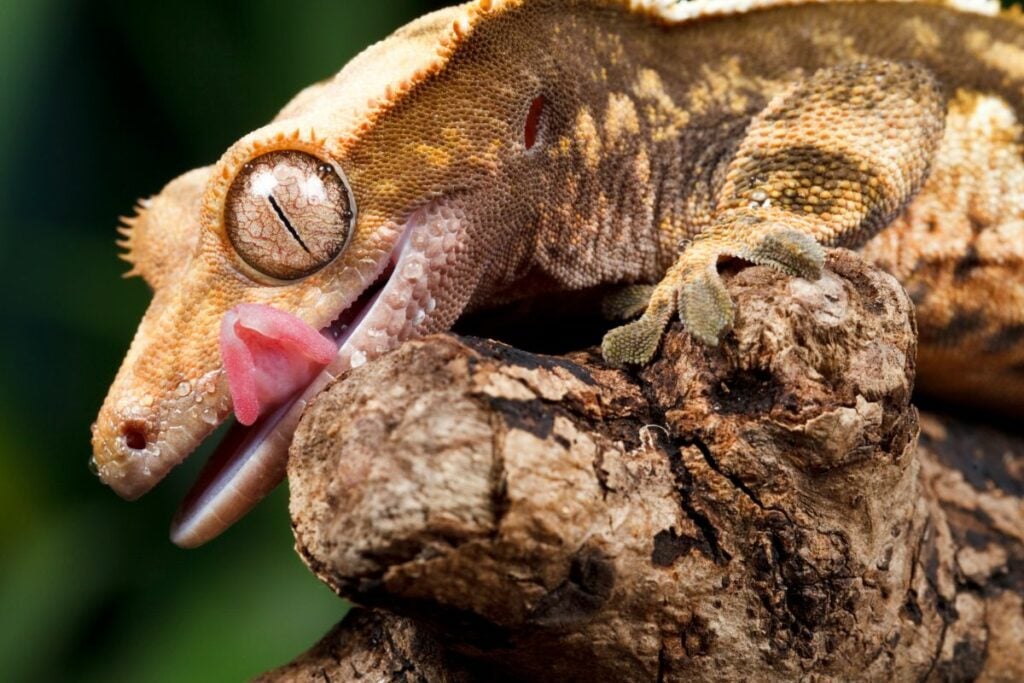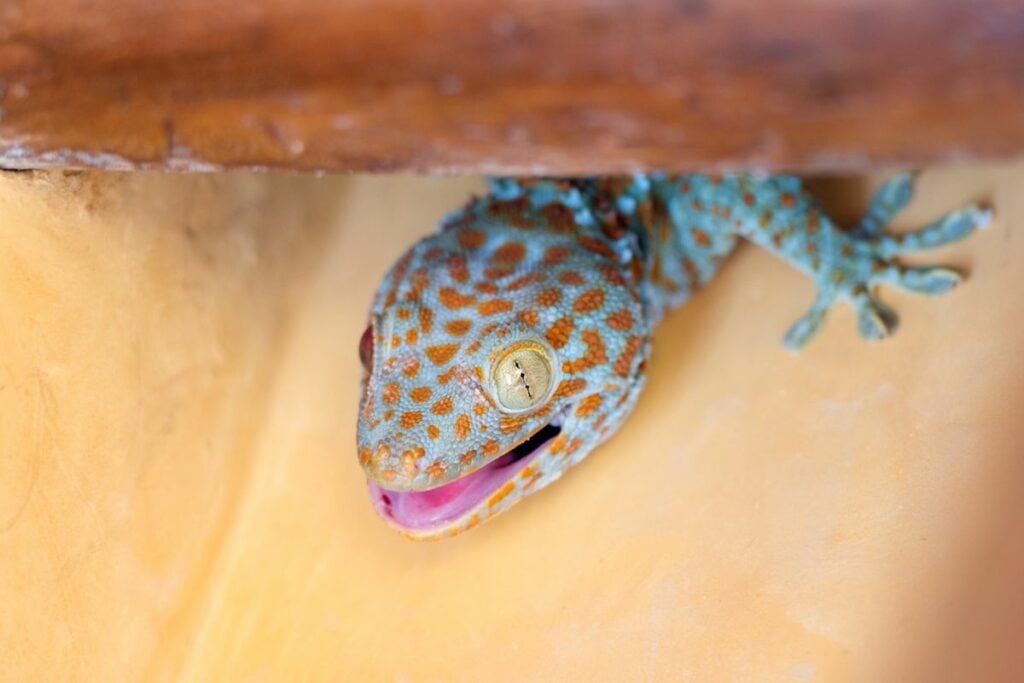Many different types of reptiles are famous for their formidable teeth. It’s part of the reason why so many people have a natural dislike or even fear of them.
It can be hard to imagine anyone being afraid of a leopard gecko, but the question of whether they have teeth and if so, what they are like is a legitimate one to ask.

This is especially the case as at first glance at least, they don’t seem to have any.
Many other reptiles have large and sharp teeth or at least a couple of fangs, but leopard geckos can look like they’re toothless and that their mouths are lined with soft gums and nothing else.
That’s why we’ve written this article to answer the question of whether leopard geckos have teeth.
We’ll tell you all about the tiny but numerous teeth in a leopard gecko’s mouth and every interesting and unique fact that you need to know.
Do Leopard Geckos Have Teeth?
Let’s start by answering the main question before we get into the details.
Leopard geckos not only have teeth, but they have around 100 of them! They have these teeth from the second they hatch from their egg but they’re so small that they’re barely visible.
The teeth are conically shaped and are found all along the upper and lower jaws of a leopard gecko.
Leopard geckos are also what is known as polyphyodonts. This means that their teeth don’t last very long and are frequently replaced.
In fact, a leopard gecko’s teeth are fully replaced every three to four months. This happens throughout their entire lifespan, from hatching to death.
Why Do They Have So Many Teeth?

Let’s go back to what we said in the last section. Leopard geckos have 100 teeth in their mouth but at first thought, it’s difficult to see why they need so many.
These reptiles don’t actually chew their food, instead, they just swallow it. Plus, the teeth they have aren’t aligned in ways to make grinding and tearing easy and they’re too small to be very effective.
The reason why a leopard gecko has so many teeth is explained by how the teeth are used (see also “Most Common Reasons Why Your Leopard Gecko Is Shedding“). Unlike many other reptiles, they don’t use their teeth to rip and tear into their food.
For leopard geckos, teeth are used to keep a tight grip on their prey before they swallow it whole.
They love to eat flying insects and if they didn’t have these little teeth to grip onto the insect, it would be able to get away before they had a chance to swallow.
Having so many teeth around their mouth means they can grip the insect whether in their mouth it is.
How Sharp Are a Leopard Gecko’s Teeth?
The teeth of a leopard geek are very, very sharp. They are shaped like cones and have sharp pointed tips.
However, the teeth are also very, very small, so they can’t really do that damage, especially not compared to the teeth of many other reptiles.
Their teeth are the right size and sharpness to deal with their small prey and any predators that may try to attack them, but they’re not going to get leopard geckos classed as dangerous animals any time soon!
The combination of sharpness and small size make the teeth of a leopard gecko more suited to gripping prey than tearing into it.
Can Their Teeth Pierce The Skin Of A Human?
If you have a leopard gecko as a pet, this is probably one of the more important questions and answers in this entire article!
You might be wondering by now if there is much chance of your beloved pet being able to break your skin and draw any blood.
There is a very slight chance of this happening, but it is very unlikely. In most cases, the pointed teeth of a leopard gecko are simply too tiny to pierce the layers of our skin.
You might feel a little scratch but blood is unlikely.
It’s not impossible, however.
What Should I Do If My Leopard Gecko Does Draw Blood?
If your leopard gecko does manage to pierce your skin and draw some blood, then there is no need to worry about this at all.
It’s only a slight injury and you can treat it the same way you would treat any small cut to your finger.
Bathe your finger in warm and soapy water to clean the wound and wash away any blood. Pat the wound dry and once the blood has stopped, you should disinfect the wound.
Then cover the wound with a Band-Aid to prevent any infection from getting into the cut. In a few days, the bite should be healed without any further problems.
The most important thing that you need to remember is to not overreact to the bite. It’s our instant reaction to snatch our hand away from anything that has hurt it but you need to be careful and make sure you don’t injure your leopard gecko in the process (see also “Giant Day Gecko Care Sheet“).
It’s so easy to snatch your hand away and send your beloved pet flying across the cage or room.
Why Would My Leopard Gecko Bite Me?
Most leopard geckos have a very calm temperament. When faced with a dangerous situation, they usually opt to flee and hide instead of fight so a bite from a leopard gecko is not a common occurrence.
There are a few situations where a leopard gecko might bite you and you should try and avoid these where possible.
A leopard gecko can lash out if it is scared or startled so try to approach your pet with a calm and steady hand and keep any aggressive leopard geckos away from more timid ones.
They can also bite from stress, which can be used by incorrect or too much handling or an incorrect tank setup.
You should also be careful as leopard geckos can occasionally think with their stomach instead of their minds and they may mistake your fingers for food or try to munch on you if they are hungry.
Do Their Teeth Fall Out?
We mentioned earlier that leopard geckos are considered polyphyodonts. This means that they replace their teeth every three to four months instead of keeping the same teeth throughout their adult lives as humans do.
When the new teeth come through to replace the old ones, the old ones have to fall out to make room for them.
Unlike the human change from milk teeth to adult teeth, leopard geckos aren’t left with a gummy smile for several months. Their teeth are replaced immediately, and this is a feature of pleurodont teeth.
Pleurodont teeth are anchored to the inside of an animal’s jaws. This is very common in many different types of lizards.
It gives the teeth strong roots but means that they can fall out easily when necessary. The teeth aren’t fused to the jawbone so the new teeth can grow in the same place as the old ones.
In the case of humans and other animals that don’t have pleurodont teeth, their replacements grow in the jaw and take time to migrate to the gums.
How Does The Teeth Replacement Work?

When leopard geckos are born, they have a full set of teeth that are already in place in the mouth and ready to go. A second set starts growing immediately and replaces that first set after around the third or fourth month.
At the same time, a third set starts growing just underneath the jaw. This is below the first two sets and it moves up and into place as the sets before it move into place and get replaced.
This is sometimes referred to as a marching molar system or hind molar progression. It is a continuous system that carries on throughout the life cycle of the leopard gecko.
The teeth start growing at the back of the jaw and keep pushing forward until the exposed teeth in the jaw have nowhere to go but out.
Think of it as either a slowly moving conveyor belt of teeth or a slowly marching army of teeth that are heading to the front lines.
Why Don’t Leopard Geckos Have Permanent Teeth?
This is a very good question! Having one set of teeth instead of the constant conveyor belt of replacement teeth does sound like a simpler idea.
Although there is no definitive answer, scientists who have studied leopard geckos think that the marching molar system is in place to prevent wear and tear.
Leopard geckos rely on their teeth to keep hold of their prey and warn off predators and their teeth aren’t sturdy enough to survive throughout their entire lifespan.
What Happens To Their Old Teeth Once They’ve Fallen Out?
As leopard geckos have 100 teeth in their mouth and they get replaced every three to four months, that means there are a lot of teeth that fall out of a leopard gecko’s mouth!
It’s estimated that the average leopard gecko can get through thousands of teeth and for particularly long-lived leopard geckos, this can add up to over 4,000 teeth.
So where do all of these teeth go?
Thankfully, the teeth fall out forwards so there is no chance of them being swallowed by the leopard gecko. Although all of a leopard gecko’s teeth fall out, they don’t all fall out simultaneously.
Instead, they fall out at different times and at different rates. This means that it’s very easy to overlook the teeth when they do fall out.
The teeth of a leopard gecko are very small and hard to spot and as there may only be one or two in the same location, you may not notice them at all unless you’re looking for them.
This is even the case with leopard geckos that live in captivity in a tank.
What Are the Teeth Made Out Of?
Although they’re very small and easily replaced, the teeth of a leopard gecko are made from the same material as any other teeth, including those of a mammal.
The bulk of the teeth is made from a substance called dentin which is a yellowish color. This material is harder than bone but softer than the outer layer of the teeth. This outer layer is enamel and it’s very hard but also very thin.
Finally, each tooth has some cementum at the base. As the name suggests, this is a form of cement and it ensures that the tooth remains in place and is anchored to the reptile’s mouth.
Are The Teeth Of A Leopard Gecko Similar To The Teeth Of Humans?
As we learned in the last section, leopard gecko teeth are made from the same materials as mammal teeth. This includes the teeth of humans.
Our teeth are also made from dentin in the center and a layer of enamel on the outside.
This is the only similarity, however.
Leopard gecko teeth fall out and are replaced every three to four months but humans only have two sets of teeth throughout their entire life, their milk teeth and their adult teeth.
As we don’t get the luxury of extra teeth, we have to take the time to keep our teeth cleaned and maintained by brushing and flossing them daily.
Leopard geckos don’t need toothbrushes when they get new teeth every few months!
There are also big differences in the number of teeth we have. Humans have 32 different teeth that can be divided into four different kinds that all serve different purposes.
Leopard geckos have 100 tiny teeth that all look and act the same. Our teeth are made to chew and tear our food, whereas leopard gecko teeth are just to grip their prey.
So as you can see, the teeth of a leopard gecko and the teeth of a human are very, very different!
What Is Mouth Rot?
As long as a leopard gecko has a balanced diet and their tank is kept in good condition, its teeth do not need any special care.
However, leopard geckos can suffer from mouth rot. This is a bacterial infection that occurs when a lesion in the gecko’s mouth becomes infected. It can also be caused by food getting stuck in their mouth and rotting.
It is a potentially fatal disease, but as long as you look after your leopard gecko correctly, it is unlikely to occur. Make sure you feed your leopard gecko the correct food and keep its tank clean as both of these can lead to mouth rot.
You can spot mouth rot by looking for any visible signs of inflammation around your gecko’s mouth or face. There may also be some secretions around the nose.
Final Thoughts
In this article, we answered many questions about leopard geckos and their teeth. We explained what their teeth are made of, how they are replaced, and the problems that can occur.
We hope that this article answered all of your questions about the teeth of your leopard gecko.
- Can Leopard Geckos Eat Silkworms? - March 11, 2024
- Do Leopard Geckos Climb? - March 4, 2024
- Do Leopard Geckos Bask? The Answer Will Surprise You - February 21, 2024
